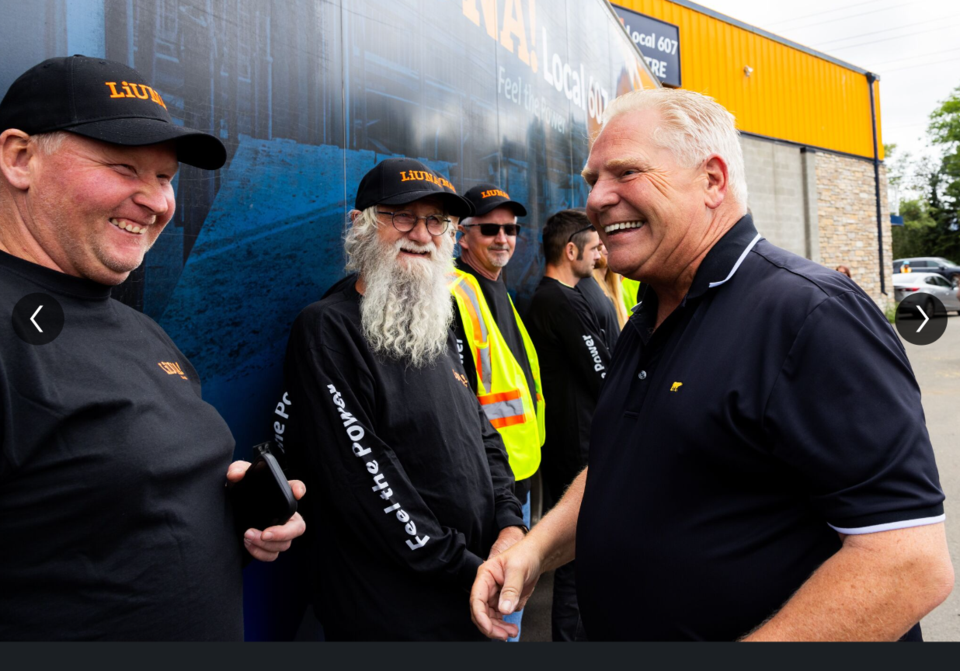It may be curtains for the Terrace Bay pulp mill under the AV Group flag, but Premier Doug Ford suggested late last week bigger and better developments are in store for northwestern Ontario.
Ford was in Thunder Bay at the LiUNA Local 67 training centre on Aug. 9 to drop $17 million from the province’s Skilled Development Fund toward training and facility upgrades to support the mining, construction, energy and forestry industries. Agnico Eagle Mines pocketed $10 million for training partnerships with Matachewan First Nation, Taykwa Tagamou Nation and Moose Cree First Nation.
Among the other recipients were the Northern Centre for Advanced Technology (NORCAT), Science North, Sheet Metal Works Union Local 397, Keewaytinook Okimakanak and International Association of Bridge, Structural, Ornamental & Reinforcing Ironworkers Local 759
In answering media questions on the future of the idled north shore mill, Ford suggested it might be time to turn the page on the mill’s owners, Aditya Birla.
The pulp producer said last January it was temporarily halting operations reportedly due to “prevailing market conditions” but has not communicated any timeline for a reopening.
Ford said his government will there to support the 400 laid off Terrace Bay workers through retraining dollars and to save the mill from the wrecking ball. But the situation to immediately reopen the mill appears to be largely out of the province’s hands.
“I wish I could dictate the market,” Ford said.
Ford didn’t provide specifics but said his government is working with front-line workers to come up with ideas to “potentially find a new buyer (and) save the mill.”
“That’s our ultimate goal to make sure they’re (mill workers) taken care of.”
With mining and mineral exploration booming in the northwest, questions soon turned to critical mineral development and the Ring of Fire.
Ford said boosting the mining sector is critical to the $43 billion in investments tied to Ontario’s burgeoning electric vehicle (EV) industry, which he touted as the leading jurisdiction in the world when it comes to EVs, “and it’s all tied to the North.”
In promoting the creation of a domestic mines-to-car-plant supply chain strategy, Ford has taken considerable heat from Indigenous leaders for his enthusiastic ‘bulldozer’ comments on building a Ring of Fire road.
Last year, the leadership of Marten Falls First Nation, one of the remote communities along the proposed road, warned chronic water and housing issues needed to be resolved before any mining takes place.
The message seems to be getting through and new relationships seemed to have formed.
Aside from committing skilled training dollars for Indigenous folks, Ford said his government is prepared to build schools, hospitals, roads and all the associated infrastructure needed to support growth in the region.
On the potential start of construction of a north-south road network to the Ring of Fire, Ford hinted he's coming back to northwestern Ontario next month, “up the road” from Thunder Bay, to make a monumental announcement.
“There’s massive investments that are going to take place.”
Ford and Aroland First Nation Chief Sonny Gagnon suggested as much in June at a funding announcement in Greenstone, northeast of Thunder Bay, for Indigenous training and infrastructure dollars for highway and retail development.
The premier appears to have a new-found ally and community development partner in Gagnon, the latter was once a defiant opponent of a Ring of Fire road. A proposed section of that network would cross the traditional territory of his community.
Aroland sits at an important logistical crossroads where mined nickle concentrate would be trucked down, some 200 kilometres, from a mine site to a likely truck-to-rail transfer facility for shipment to a proposed processing plant in Sudbury.
Securing Indigenous consent along that route, including from Aroland, is key to making that happen.
“I’m just so grateful for the chief’s support,” Ford said of Gagnon. “He is an absolute champion. He thinks outside the box.”
Ford insisted mining will bring spinoff benefits to Indigenous communities through economic opportunities, better access to health care and reliable energy brought to their doorsteps.
Through Hydro One, the province is spending $200 million to extend grid power to remote communities, which are reliant on expensive loca diesel-generated power.
“It’s just a massive, massive win for them and they’re going to get the proper training,” Ford said.




